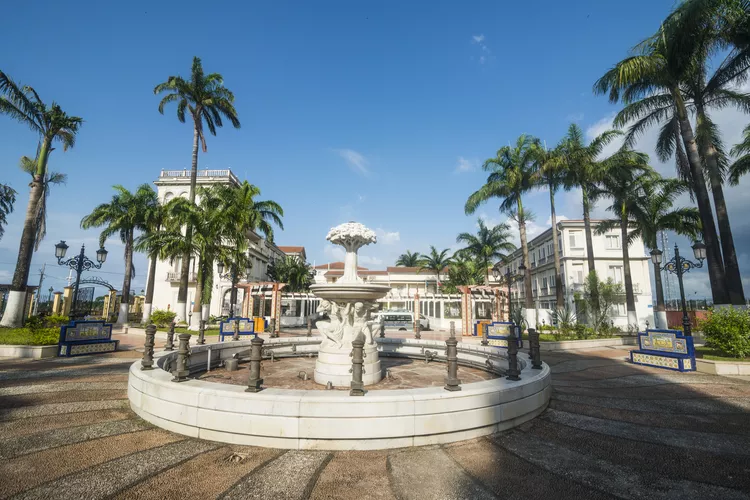Summary of Equatorial Guinea Travel Guide
Equatorial Guinea is one of the African continent’s least visited countries. It has a reputation for political instability with a history full of coups and corruption; and although vast offshore oil reserves generate huge wealth, the majority of Equatoguineans live well below the poverty line. However, for those in search of a totally different vacation experience, Equatorial Guinea offers plenty of hidden treasures. Pristine beaches and dense forests filled with endangered primates are just part of the country’s considerable charm.
Location:
Despite its name, Equatorial Guinea is not on the equator. Instead, it is located on the coast of Central Africa, sharing borders with Gabon to the south and east, and Cameroon to the north.
Geography:
Equatorial Guinea is a small country with a total area of 10,830 square miles (28,051 square kilometers). This area includes a slice of continental Africa and five inhabited islands. To give an idea of its size, Equatorial Guinea is slightly smaller than the U.S. state of Maryland.
Capital City:
The capital of Equatorial Guinea is Malabo, a laid-back city located on the offshore island of Bioko.
Population:
According to the CIA World Factbook, July 2018 estimates put Equatorial Guinea’s population at 797,457. Fang is the largest of the nation’s ethnic groups, accounting for just over 85% of the population.
Language:
Equatorial Guinea is the only Spanish-speaking country in Africa. The official languages are Spanish and French, while commonly spoken indigenous languages include Fang and Bubi.
Religion:
Christianity is widely practiced throughout Equatorial Guinea, with Roman Catholicism being the most popular denomination.
Currency:
Equatorial Guinea’s currency is the Central African franc. For the most accurate exchange rates, use a reliable currency conversion website.
Climate:
Like most countries located near the equator, temperatures in Equatorial Guinea remain constant throughout the year and are dictated by elevation rather than season. The climate is hot and humid, with plenty of rainfall and lots of cloud cover. There are distinct rainy and dry seasons, although the timings of these depend on where you’re going. Generally, the mainland is dry from June to August and wet from December to February, while the seasons on the islands are reversed.
When to Go:
The best time to travel is during the dry season, when the beaches are most pleasant, dirt roads are in the best condition, and forest treks are at their easiest. The dry season also sees fewer mosquitoes, which in turn reduces the likelihood of mosquito-borne diseases like malaria and yellow fever.
Key Attractions:
Malabo: Equatorial Guinea’s island capital is primarily an oil town and the surrounding waters are littered with rigs and refineries. However, a wealth of Spanish and British architecture provides a picturesque insight into the country’s colonial past, while street markets burst with local color. The country’s tallest mountain, Pico Basilé, is within easy reach, while Bioko Island boasts some beautiful beaches.
Monte Alén National Park: Covering 540 square miles (1,400 square kilometers), Monte Alén National Park is a veritable wildlife treasure trove. Here, you can explore forest trails and go in search of elusive animals including chimpanzees, forest elephants, and the critically endangered mountain gorilla. Bird species are prolific here, and you can even arrange to stay overnight in one of the park’s forest campsites.
Ureka: Located 30 miles (50 kilometers) south of Malabo on Bioko Island, Ureka village is home to two beautiful beaches – Moraka and Moaba. During the dry season, these beaches offer the opportunity to watch as sea turtles emerge from the ocean to lay their eggs. The surrounding area is also home to pristine jungle and the beautiful waterfalls of the Eoli River.
Corisco Island: Remote Corisco Island is situated to the south of the country near the border with Gabon. It is the archetypal paradise island, with deserted white sand beaches and shimmering aquamarine waters. Snorkeling and scuba diving are both excellent here, while the island’s ancient cemetery dates back some 2,000 years and is thought to be one of the oldest in Central Africa.
Getting There:
Most visitors fly into Malabo International Airport (SSG), which is also known as Saint Isabel Airport. The airport is located approximately 2 miles (3 kilometers) from the capital and is serviced by international airlines including Ethiopian Airlines, Lufthansa, and Air France. Most nationalities (except people from the U.S., China, Barbados, and all CEMAC countries) require a visa to enter Equatorial Guinea, which must be obtained in advance from a nearest embassy or consulate.
Medical Requirements:
If you are from or have recently spent time in a country where yellow fever is present, you will need to provide proof of yellow fever vaccination before being allowed to enter Equatorial Guinea. Yellow fever is endemic within the country, too, so vaccination is recommended for all travelers. Other recommended vaccines include typhoid and hepatitis A, while anti-malaria prophylactics are also strongly advised. Always check the latest health advice before traveling.





